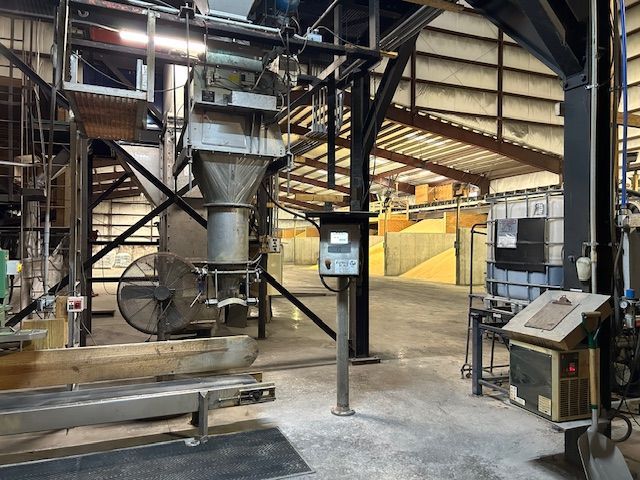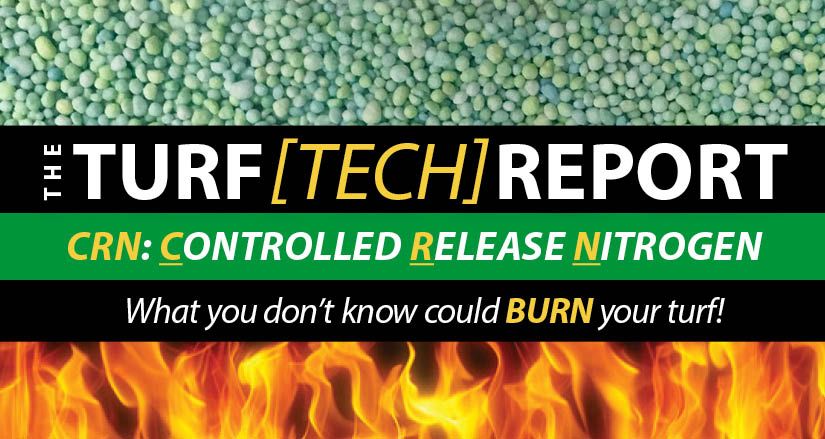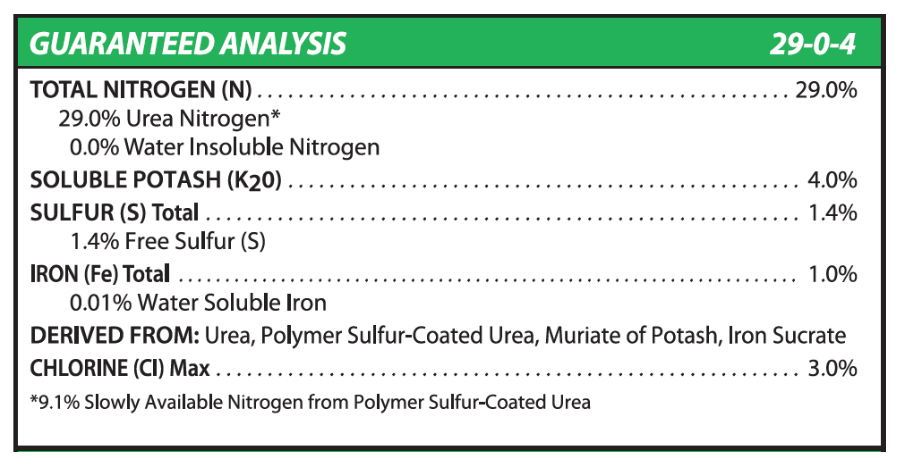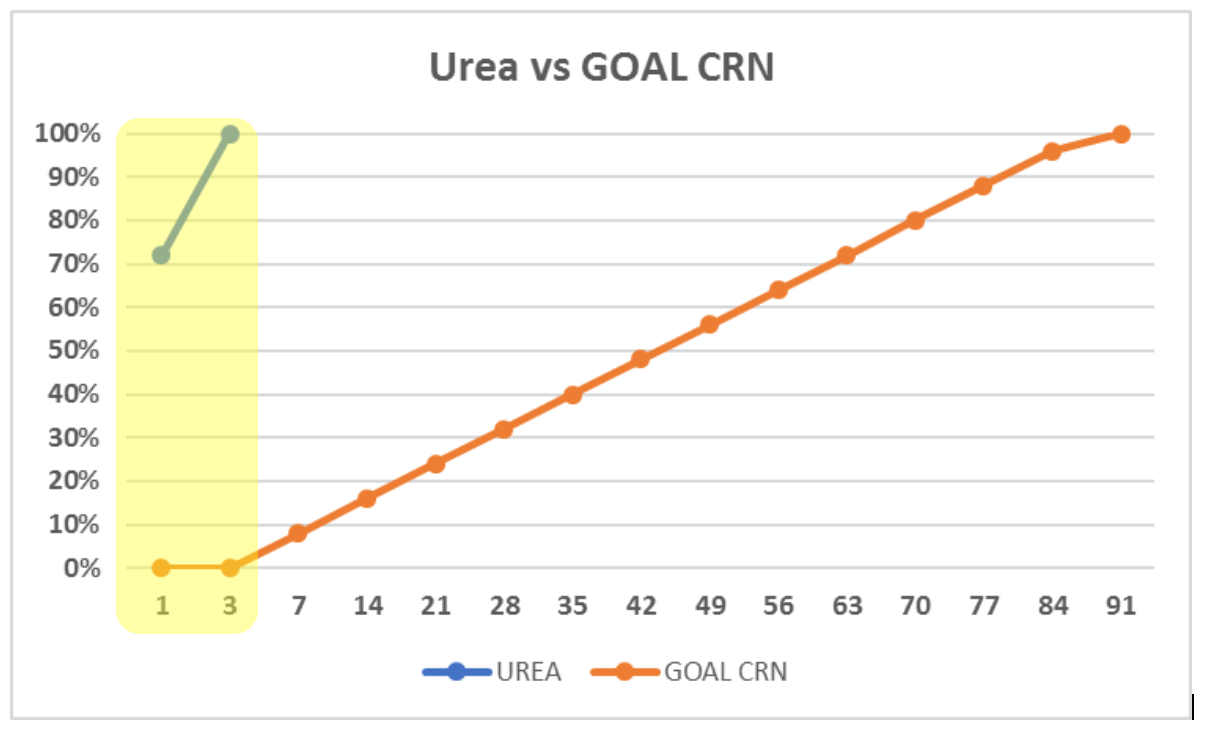WHAT IS CONTROLLED RELEASE NITROGEN?
Controlled Release Nitrogen (CRN) consists of uniform granules (usually urea-based) designed to release nitrogen into the soil over an extended time period. This is as opposed to straight urea, which is considered to be ‘immediately available nitrogen.’ The mechanism for controlling the release of nitrogen is a physical barrier. Controlled release nitrogen is typically encapsulated by a combination one or more layers of polymer, sulfur and wax. These layers work in tandem to control the rate that water enters the granule, then control the rate at which dissolved urea nitrogen leaves the granule.
WHAT COATING TECHNOLOGIES ARE AVAILABLE AND HOW DO THEY COMPARE?
Sulfur Coated Urea (SCU)
was the first type of CRN to hit the market nearly 50 years ago. Sulfur is very effective at repelling water, however sulfur coatings are extremely brittle. The Sulfur coating fractures allowing water to find its way inside, the granule expands, further fracturing the sulfur coating. Once this occurs, dissolved urea flows out quickly. SCU works on the premise that some granules will take longer to fracture and release their nutrients than others. Over the course of time, this “mix” of release times results in continuous nitrogen feeding until the last granules have fractured. Most products have a wax that is applied atop the sulfur layer to slow the rate of nitrogen release by protecting the Sulfur layer.
Temperature can also affect CRN granules coated with wax because waxes are slowly broken down by soil microbes (microbes are more active in warmer soil temperatures). In recent years, SCU has been enhanced by hardeners and or polymers that further protect the inner brittle sulfur layer or protect the water from reaching the inner granular, effectively stabilizing the release curves of SCUs. These enhanced SCU base products which combine polymers are often referred to as Polymer coated sulfur coated ureas. XCU® is an example of an advanced SCU or PCSCU.
Polymer (or Plastic) Coated Urea (PCU)
generally has longer and more stable release properties vs most SCU based products. PCU granules can consist of one or more polymer layers allowing for greater extended release times. Polymer coatings are less susceptible to fracturing (abrasion) during transport than sulfur coatings thus their release times are more consistent. Through osmosis, water diffuses through the polymer layer and slowly dissolves the urea core. Over the course of many weeks or months, urea slowly dissolves through the polymer layer providing an even, controlled distribution of nitrogen over a large portion of the growing season. Once the urea has been depleted, the thin polymer shell is biodegraded naturally by soil microbes, making PCU technology very efficient and environmentally friendly. DURATION® is an example of an advanced PCU.
HOW TO READ A CRN LABEL
Every fertilizer label contains an N-P-K analysis and a derived-from statement. The analysis shows the percent by weight of each element inside a fertilizer bag. The derived-from statement shows what raw ingredients those elements are derived from. In addition to an analysis and a derived-from statement, every label must also show the guaranteed percent of “slowly available nitrogen,” and the source of that nitrogen.
Take for example TCS Growstar’s 29-0-4 Professional Lawn Fertilizer + Iron. This blend contains both Urea and Polymer Sulfur-Coated Urea (PSCU). 29% of the entire bag by weight is nitrogen. 9.1% of the entire bag by weight is nitrogen derived from PSCU. That means that 31.3% of the total nitrogen is CRN (from PSCU) and 68.7% of the total nitrogen is urea.
WHAT IS A DISSOLUTION RATE?
Every controlled-release fertilizer has a dissolution rate associated with it. The dissolution rate refers to how much dissolved urea has been depleted (or released) over a time period. In general, the industry goal is to manufacture CRNs with minimal to no release in the first 3 days, because urea is providing the Nitrogen during the first 3 days. Then from day 4 to the desired days of release (typically 45,90,120,180) a consistent release on nitrogen each week (see chart 1) is optimal, however in reality most dissolution rate curves varying by CRN type. CRN products can last anywhere from 30 days to up to 180 days. In general, 30-day products have thinner coatings, so they deplete their nitrogen faster. 180-day products have thicker and multiple coatings, often consisting mainly of polymer. More coatings and or thicker coatings translate to products with longer dissolution rates. Not surprisingly, these products take more time to manufacture and use more coating components, hence they drive a premium price point.
Urea vs. GOAL CRN (chart 1): Note that in this chart, urea is depleted within the first 3 days of being applied to the ground. This is why manufacturers strive to create CRN products that don’t release any nitrogen until shortly after straight urea has been depleted.
1stGeneration SCU vs. Improved SCU (chart 2): Note that 1stGeneration SCU products typically release up to 30% of their nitrogen within the first few days; this is undesirable as most fertilizer blends already have straight urea in them. Improved SCU products demonstrate a nearly 20% reduction in nitrogen release in the first few days; this is desirable. Why pay a premium for CRNs that behave like straight urea within the first few days of their application?
Basic PCU vs. Improved PCU (chart 3): Note that with improved PCU, nitrogen release is delayed within the first week (this is desirable), and that the overall release curve is much straighter than that of basic PCU. Many improved PCU products now last well beyond 90 days with consistent and predictable nitrogen release week to week.
THE EVOLUTION OF CRNS OVER TIME
Take a look at the dissolution rate curves in the graph above. These curves do not represent specific CRN products, but rather demonstrate the evolution of classes of CRN products over time. First, note that straight urea (46-0-0) releases nearly all of its nitrogen within 3 days under normal conditions (chart 1). Urea is the best source of nitrogen on a cost per ton basis, hence urea is the base raw ingredient for nearly all CRN products.
Next, look at (chart 2) basic SCU (invented in the late 1960s). Note that basic SCU releases nearly 30% of its nitrogen within the first day or two. Its release curve mimics a standard logarithmic curve, meaning compared to other CRNs, it releases more of its nitrogen earlier in the curve. Given this challenge (too much nitrogen release within the first few days), manufacturers and agronomists were determined to reduce this initial nitrogen load into the ground. This led to the development of polymer coated urea (PCU) several decades later. In addition to quelling the early nitrogen release problem associated with first generation SCU, PCU also brought straighter, more consistent release curves to the industry (chart 3). Today’s improved PCU products have release curves that mimic a shape of a hockey stick, resulting in more gentle transitional nitrogen feeding for turf. Improved PCU products have also been engineered to reduce lock-off issues, and last longer in the field.
Last, the higher costs associated with components and manufacturing improved PCU products has led to the development of improved or “enhanced” SCU products. Improved SCU uses hardeners and or polymers and or waxes to mitigate the early nitrogen release issues associated with 1stgeneration SCU products. Improved SCU products are also more resistant to abrasion and have longer release windows. Some improved SCU products now last as long as 90 days in the field.
HOW DO I CHOSE THE RIGHT CRN FOR ME?
Choosing the right CRN comes from an understanding the dissolution rate (or release curve profile) of each CRN, and then deciding which CRN gives you the nitrogen you need when you need it. For example, an applicator who only likes to drop fertilizer in the spring may want to pay a premium for a 180-day CRN, that way he or she only has to fertilizer once per year. In most cool season grass climates, a 180-day product will make it through most of the growing season (year to year variations in weather will affect the performance of a 180-day product). Conversely, a lawn care business might prefer a 45-day product such as XCU, due to sporadic weather conditions, financial factors, specific agronomic / control programs, etc. This isn’t necessarily a bad thing for lawn health either; more nitrogen is making into soil and being taken up by the plant per year than dropping a 180-day product only once per year. You should pick your CRN product based on how it fits into your turf maintenance program. For example, if you only fertilizer twice per year, two 90-day products might be right for your situation. If you’re a golf course superintendent, you might prefer to “spoon-feed” your turf, which means you might want to use 30-day products 5-8 times per year. It all depends on your climate and the nature of your turf maintenance program.
WHAT ARE THE EFFECTS OF APPLYING LOW-QUALITY CRN PRODUCTS TO TURF?
The whole concept behind CRN products is that they release nitrogen slowly and evenly over time. Low quality coatings are more susceptible to fracturing through abrasion (the colliding of CRN granules against each other during storage and transport). This is why most CRN products guarantee up to about 90% of their slow-release integrity on the bag. (What this means is, if you had a 50 LB bag of pure 39-0-0 SCU, about 10% of the bag would be considered ‘immediate release’ due to the fracturing of about 10% of the SCU granules during storage and transport. Fractured coatings are considered ‘compromised’ and are treated the same as straight urea from a labeling standpoint.) Low-quality CRN products run the risk of behaving like straight urea, which means they have the potential to burn or even kill a lawn. Before purchasing any CRN, ask for dissolution rate data and don’t hesitate to dig into that product’s industry reputation.
For professional fertilizers, humic and AMP-XC™ enriched products available, please visit TurfCare’s online Product Catalog.
For green industry professionals or others interested in ordering Turfcare products, please contact our Customer Service
to find a distributor near you.
Turf Care Supply - TurfReport Blog

Turf Care Supply, LLC, a portfolio company of Platte River Equity, has officially acquired Beaty Fertilizer, the industry respected Tennessee-based manufacturer and blender of custom granular and liquid fertilizers, as well as combination products. This strategic move expands Turf Care’s manufacturing footprint, adds new product capabilities, and enhances overall production capacity. “The partnership with Beaty Fertilizer marks a major milestone in our journey and an important step forward in our mission to grow, innovate and lead in our industry,” said Mark Mangan, President of Turf Care. “This acquisition is more than just expansion; it’s a powerful opportunity to strengthen our product offerings, broaden our market reach and provide greater value to our customers. By welcoming Beaty into the Turf Care family, we are reinforcing our commitment to excellence and positioning ourselves for an even brighter future.” “We are excited about this next step in the Beaty Fertilizer story. For almost 50 years, our family and our employees have worked hard to serve customers and communities with pride and heart,” said John Beaty, President of Beaty. “Now, we are embracing an opportunity for growth with Turf Care. With our combined know-how and resources, we’ll keep building on what we’ve worked so hard to create and bring even more value to our customers, employees and partners. We truly believe this partnership will keep the Beaty legacy going strong while opening up new doors for growth and innovation.” Tarun Kanthety, Vice President at Platte River, added, “We believe the acquisition of Beaty Fertilizer represents a strategic step in expanding Turf Care’s footprint and product breadth... as it scales and enhances its value proposition to customers.”

Root out Grubs, Before they Attack Yours! White grubs, the immature stage of several scarab beetles—including Japanese beetles, masked chafers, May and June beetles, and green June beetles—are a major threat to turfgrass across the Southeast. These beetles follow a complete metamorphosis (egg, grub, pupa, adult), with most species completing their cycle in one year. Eggs are laid in early summer, grubs hatch within two weeks, and begin feeding on turfgrass roots through the late summer and fall. May and June beetles differ slightly, with a two- to three-year life cycle and prolonged feeding as third-instar grubs. Grubs damage turf by severing roots, causing grass to yellow, wilt, or lift easily from the soil. Feeding is typically concentrated in patches and worsens during hot, dry weather. Wildlife digging for grubs can create further turf destruction. Healthy turf may tolerate 5–10 grubs per square foot, but damage becomes evident as populations rise or turf is under stress. Early detection and timing are essential. Scouting begins in late June, shortly after adult beetle activity peaks. Monitoring plants favored by beetles can signal egg-laying is underway. Treatment is most effective when small grubs are active—typically from mid-July through early August. For professional turfgrass managers, insecticides containing imidacloprid (Merit®), chlorantraniliprole (Acelepryn®), or trichlorfon (Dylox®) are the most effective tools. The primary months of preventative application of Acelepryn® is from April to end of May and Merit® from April into July - targeting grubs before they hatch. Curative treatments with Dylox® or similar products are applied July through the fall, when young grubs are feeding and most vulnerable. Always follow label directions for optimal application and safety. Timing may vary slightly by regional seasonal needs. Turf Care Supply has a variety of professional TCS Growstar insecticide fertilizers available to protect your turf and prevent grub damage, before it starts. Click on the button below to view products, contact your sales rep for addition TC Growstar products available.

Platte River Equity Portfolio Company Turf Care Supply, LLC Acquires Agri-Nutrients, Inc. Brunswick, OH , October 9, 2024 – Platte River Equity (“Platte River”) portfolio company Turf Care Supply, LLC (“Turf Care”) is pleased to announce its acquisition of Agri-Nutrients, Inc. (“Agri-Nutrients”), a manufacturer and blender of custom granular fertilizers for the turf & ornamental (“T&O”) industry. This strategic acquisition provides Turf Care with an established presence in the south-central United States, an enhanced product portfolio and additional manufacturing capacity. “This acquisition represents much more than a business transaction; it is a strategic step forward in expanding our reach and enhancing our customers’ growth. By bringing Agri-Nutrients into the Turf Care family, we are broadening our product portfolio, expanding our market presence and further positioning ourselves as a leader in providing innovative solutions for our customers,” said Mark Mangan, President of Turf Care. “We are excited about joining the Turf Care team,” said Jim Montgomery, President of Agri-Nutrients. “At Agri-Nutrients, our core values center around customer service and product innovation, and we are confident that this combination will allow us to better serve the needs of our customers.” “Platte River welcomes the Agri-Nutrients team to Turf Care. This transaction underscores our long-term commitment to fostering growth through both organic and inorganic initiatives across the Turf Care platform,” said Tarun Kanthety, Vice President of Platte River. “The partnership with Agri-Nutrients strengthens Turf Care’s value-added offering, creating additional growth opportunities across the combined customer base.” B&A Corporate Advisors served as the exclusive financial advisor to Agri-Nutrients. About Agri-Nutrients Founded in 1992 and based in Catoosa, OK, Agri-Nutrients is a manufacturer and blender of custom granular fertilizers for the T&O industry, predominantly selling into the lawn care, sports turf and golf course end markets. About Turf Care Supply Established in 1974, Turf Care Supply is one of the largest formulators and blenders of urea products to the T&O market. Turf Care has a comprehensive product portfolio of fertilizers, combination products (herbicide/insecticide), soil amendments and enhanced efficiency fertilizer ingredients. Turf Care's products are sold to distributors and blenders serving the commercial, residential and golf end markets. Turf Care operates four manufacturing facilities strategically located throughout the eastern U.S. About Platte River Equity Founded in 2006 and based in Denver, CO, Platte River Equity is a private equity firm focused on investments in established lower middle market operating companies within targeted industrial sectors where it has substantial operating and investing experience. Platte River utilizes prudent capital structures in order to invest in future growth opportunities and withstand changing economic environments. The firm also provides significant ongoing support to its portfolio companies through dedicated resources across functional areas. The firm has raised funds with committed capital in excess of $1.6 billion and is currently investing out of its fifth fund. The Platte River team is the largest collective investor across its funds, deeply aligning the firm with its investors and portfolio company management teams.





